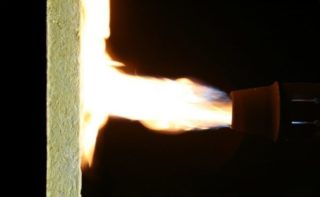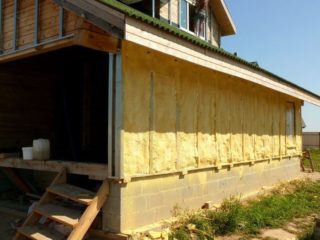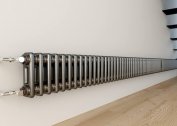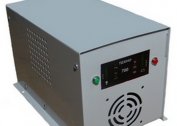The base of the structure is exposed to soil moisture and temperature surges. Warming of a wooden house outside with mineral wool for siding is necessarily carried out in the basement area in order to reduce heat loss through cold bridges and extend the life of the house.
Types of mineral wool
The structure of the insulation depends on the raw material and differs in different directions of the fibers, which affects the properties of the material. Technologically different spatial, horizontally layered, corrugated or vertically layered structure.
Mineral wool is of three types:
- glass;
- stone;
- slag.
The material is used to isolate from heat leaks through walls, floors. Minvata is used to sheathe the surface of high-temperature industrial furnaces, to insulate pipelines, aerodrome sites, and embankments on the railway. It is also suitable for cladding the facade and basement of log wooden houses and serves as additional protection against penetrating noise.
Physical characteristics of mineral wool:
- Thermal conductivity (λ) is in the range of 0.036 - 0.041 W / mK. The indicator depends on the density and structural features. The passage of energy becomes larger during the operation, because the material gets wet and loses its original qualities. Thermal conductivity decreases by about 40% after three years of operation.
- The limit of heat resistance occurs when the temperature reaches +600 - 700 ° C.
- The vapor permeability index is equal to one, unless an additional barrier is placed to retain moist air.
- Slaggy
- Stone wool
- Glass wool
The use of resin as a binder component is not more than the regulation and does not exceed 4%. Substances that are resistant to operating conditions are allowed. The purpose of standardization is to ensure that the content of harmful components in the environment is not more than the volume of the maximum concentration of toxic substances (MPC).
Stone
Isolation is carried out by the method of melting mountain erupting rocks, the raw materials are gabbro-basalt species and metamorphs and marls similar in chemical composition. The acidity coefficient is an indicator of the quality of the material and expresses the ratio of oxides and acid bases. The water resistance of cotton wool depends on this module and increases with increasing rate.
Binders are used to bond fibers:
- bituminous;
- synthetic;
- substances of complex composition;
- bentonite clays.
Stone wool refers to non-combustible categories of materials, when it reaches + 700 ° C, the fibers melt and break up into dust. High porosity helps to effectively retain heat, enclosed air particles are contained inside in a static state. Density varies from 30 to 220 kg / m3, so the physical and mechanical properties vary depending on the species. Rigid slabs withstand up to 700 kg / sq. m
Products are coated on one or two sides with kraft paper, aluminum foil, fiberglass. The material is characterized by durability, environmental friendliness, good air permeability, high thermal insulation. Cotton wool is produced in the form of plates and mats, formed by the type of segments and cylindrical products.
Fiberglass
For the production of glass wool, raw materials similar to those taken for the manufacture of glass are used, the use of small cullet is allowed. The category includes soda, limestone, sand, dolomite, borax. Binder polymer solutions of phenol-aldehyde with the inclusion of urea are used to bind the strands after melting and blowing with steam.
Moisture is removed in the temperature compartments, cotton wool gets hardness. The material enters the cutting conveyor after cooling, where mats are formed or rolls roll. The insulation is characterized by a large volume due to internal air, therefore it is pressed for transportation and restores the original volumes after installation in the structure.
Glass wool has fibers that are 3 times longer than other types of mineral insulation. Products are characterized by increased strength and elasticity, effectively resist vibration, and do not sag when working in the structure. The decay of the fibers begins when the temperature reaches + 450 ° C.
The material is available in the form of soft plates and mats, rigid panels that withstand loads. Grooves and ridges are provided at the end of the products for reliable connection without gaps. Soft panels roll into rolls by pressing. The production technology provides for the production of glass wool with a protective layer of foil or fiberglass to prevent the spread of fibers.
Ecowool
The material is a loose insulation of light gray or gray color with a light fibrous structure. For production, recycled waste paper (80%) and flame-retardant non-volatile components are used, borax and boric acid, which are low toxic, are more often used. Ligin in the composition of the mass works as an astringent when moisturizing ecowool.
The cellulose insulator withstands open fire, thanks to additives, it has high sound insulation and heat retention indices. The material retains up to 20% moisture in the outer layer, which has little effect on heat-insulating qualities. Ecowool easily gives moisture to the surrounding space and after drying retains its declared properties. The density is 27-65 kg / m3.
Fire resistance depends on the production technology:
- moderate flammability - G2;
- average flammability - B2;
- with moderate smoke - D2;
- the spread of fire on the surface - RP-1.
Ecowool has low air and vapor permeability, is moistened by 16-18% for three days in a wet environment. The material is characterized by low acidity and does not lead to corrosion of metals in direct contact.
Cellulose insulation goes on sale in compressed (2-3 times) form, packed in a plastic bag. It is brought to its initial state before installation when using blower mechanisms.
Advantages and disadvantages of using mineral wool
Minvata is used not only for warming a wooden house for siding, but also for insulation of pipelines and equipment with high temperature. This is made possible due to the high fire resistance. The structure of the mats allows the use of mineral wool to insulate curved structures.
Positive properties of the material:
- low thermal conductivity due to the fibrous structure;
- effective thermal insulation;
- high vapor permeability;
- resistance to damage;
- durability;
- ease of installation, allowing you to do the insulation yourself.
The material has flaws. Manufacturers characterize mineral wool as insulation that allows moisture to pass through but does not accumulate it. The material is characterized by the ability to retain water inside, which reduces its characteristics. It is necessary to make a waterproofing gasket. Some types of cotton wool contain water-repellent additives to reduce absorption.
Tools and materials
Special tools and fixtures are required to make insulation of the house from the outside with mineral wool for siding. The material is procured based on the required number of layers. A waterproofing layer is taken, in its quality is used an adhesive material, for example, roofing material. Protection against moisture is done by coating - bitumen or modern compounds are used for work.
The next material is mineral wool. For the basement, stone wool or a fiberglass variety is used. You will need a metal profile on which to mount the siding. To fix to a brick base, foam block or aerated concrete, hardware is used.
Need tools:
- assembly knife with spare blades;
- construction level, tape measure;
- electric hammer drill, drill, grinder;
- bitumen brush.
It is not recommended to make a frame from a bar, because the material nourishes moisture and can bend over time. As a finish, siding is taken.
Basement insulation in the house outside
The foundation of a timber house is in direct contact with the soil and the building, therefore it transfers moisture and low temperature to the log house. The dew point shifts inside the base when the thermal insulation is installed inside, in the basement or under the floor, humidity rises, dampness and mold forms. Correct external insulation eliminates the formation of dew outside and inside, additionally protects the plane from the action of the sun, rain, snow, wind loads.
The isolation of the basement is done simultaneously with the construction of the house, but protection is not always done on time. To make thermal insulation after the construction of the house is completed, you need to dig out the foundation and make a trench nearby. The insulation together with the siding will create additional thickness, which will significantly extend beyond the basement.
The walls of the wooden building will not freeze, because the base will not transmit cold to them. Bacteria, germs, rodents do not live in the base layer of mineral wool insulation. An optimal indoor microclimate is created in the basement if the foundation is a building envelope for it. At the same time, the floor in the living room is not cooled and maintains a comfortable temperature.
Work stages
The trench next to the foundation should be of such a width that there could be a worker and do the work. The underground surface is only insulated, and part above the ground is finished with siding. The basement plane is cleaned of deposits and leveled. According to the instructions, such preparation is needed so that the metal rails of the frame are easier to attach to the plane and level.
Step-by-step technology of work:
- Waterproofing is applied to the foundation surface in two layers. Bitumen is preheated, the plane is coated with a brush. The second layer is performed after the previous one has hardened. Work is carried out at an air temperature not lower than + 5 ° C, otherwise the material will solidify for a long time.
- Mineral insulation is attached to the surface using dowels, fungi (with a wide hat). The overlap of the sheets is done with the approach of the ends by 10-15 cm.
- One more layer of insulation is made with roofing material after installation of the insulating insulator. Roll material is fastened with dowels.
- The underground part is covered with soil at the soil level. After this, a blind area with a width of at least 80 cm is performed at an angle from the wall of the house.
- The frame for siding is performed on the aerial part of the basement. Reiki fasten in thickness with the help of expansion bolt shields. The distance between the vertical elements is 60 cm.
- The surface of the cap is finished with siding, and the material is attached to a horizontal surface.
A galvanized visor is made above the horizontal ledge of the base so that rain does not flow between the wall and the protective insulation. A visor around the perimeter crashes into a wooden blockhouse wall.At the bottom, the siding with the frame is on the blind area, so there will be no leakage, moisture will slide down the blind area in the direction from the house.












